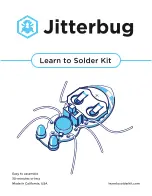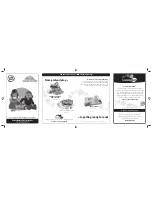
14
EN
FCC Information
This device complies with part 15 of the FCC rules. Operation is subject to the following two conditions: (1) This device may not cause harmful interference, and
(2) this device must accept any interference received, including interference that may cause undesired operation.
CAUTION:
Changes or modifications not expressly approved by the party responsible for compliance could void the user’s authority to operate the equipment.
This product contains a radio transmitter with wireless technology which has been tested and found to be
compliant with the applicable regulations governing a radio transmitter in the 2.400GHz to 2.4835GHz frequency range.
Antenna Separation Distance
When operating your Spektrum transmitter, please be sure to maintain a separation distance of at least 5 cm between
your body (excluding fingers, hands, wrists, ankles and feet) and the antenna to meet RF exposure safety requirements
as determined by FCC regulations. The illustrations below show the approximate 5 cm RF exposure area and typical hand
placement when operating your Spektrum transmitter.
AMA National Model Aircraft Safety Code
Customer Service Information
Country of Purchase
Horizon Hobby
Address
Phone Number / Email Address
United States
Sales
4105 Fieldstone Rd
Champaign, Illinois, 61822 USA
(800) 338-4639
United Kingdom
Horizon Hobby Limited
Units 1-4 Ployters Rd
Staple Tye
Harlow, Essex, CM18 7NS, United Kingdom
+44 (0) 1279 641 097
Germany
Horizon Hobby GmbH
Christian-Junge-Straße 1
25337 Elmshorn, Germany
+49 (0) 4121 2655 100
France
Horizon Hobby SAS
14 Rue Gustave Eiffel
Zone d’Activité du Réveil Matin
91230 Montgeron
+33 (0) 1 60 47 44 70
China
Horizon Hobby – China
Room 506, No. 97 Changshou Rd.
Shanghai, China 200060
+86 (021) 5180 9868
Effective January 1, 2011
A. GENERAL:
A model aircraft is a non-human-carrying aircraft capable of sustained flight
in the atmosphere. It may not exceed limitations of this code and is intended exclusively
for sport, recreation and/or competition. All model flights must be conducted in accor-
dance with this safety code and any additional rules specific to the flying site.
1. Model aircraft will not be flown:
(a) In a careless or reckless manner.
(b) At a location where model aircraft activities are prohibited.
2. Model aircraft pilots will:
(a) Yield the right of way to all man carrying aircraft.
(b) See and avoid all aircraft and a spotter must be used when appropriate. (AMA
Document #540-D-See and Avoid Guidance.)
(c) Not fly higher than approximately 400 feet above ground level within three (3)
miles of an airport, without notifying the airport operator.
(d) Not interfere with operations and traffic patterns at any airport, heliport or
seaplane base except where there is a mixed use agreement.
(e) Not exceed a takeoff weight, including fuel, of 55 pounds unless in compliance
with the AMA Large Model Aircraft program. (AMA Document 520-A)
(f) Ensure the aircraft is identified with the name and address or AMA number of the
owner on the inside or affixed to the outside of the model aircraft. (This does not
apply to model aircraft flown indoors).
(g) Not operate aircraft with metal-blade propellers or with gaseous boosts except
for helicopters operated under the provisions of AMA Document #555.
(h) Not operate model aircraft while under the influence of alcohol or while using
any drug which could adversely affect the pilot’s ability to safely control the
model.
(i) Not operate model aircraft carrying pyrotechnic devices which explode or burn, or
any device which propels a projectile or drops any object that creates a hazard
to persons or property.
Exceptions:
• Free Flight fuses or devices that burn producing smoke and are securely
attached to the model aircraft during flight.
• Rocket motors (using solid propellant) up to a G-series size may be used
provided they remain attached to the model during flight. Model rockets
may be flown in accordance with the National Model Rocketry Safety
Code but may not be launched from model aircraft.
• Officially designated AMA Air Show Teams (AST) are authorized to use
devices and practices as defined within the Team AMA Program Docu-
ment (AMA Document #718).
(j) Not operate a turbine-powered aircraft, unless in compliance with the AMA turbine
regulations. (AMA Document #510-A).















































